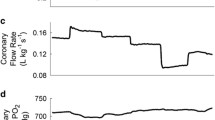Abstract
Background Non-hypertrophied reversibly injured postischemic myocardium can be stimulated for a prolonged period without detrimental effects. Since no data on hypertrophied myocardium are available, our aim was to examine the effects of a prolonged postischemic positive inotropic stimulation on moderately hypertrophied left ventricles.
Methods Using a Langendorrf-type isovolumically contracting isolated heart model, moderately hypertrophied (+50% of ventricular mass) hearts from spontaneously hypertensive rats (SHR) were investigated and compared to data from non-hypertrophied hearts of normotensive rats. A 30 minutes noflow ischemia was performed, and in the postischemic period dopamine was continuously administered for 20 minutes in order to stimulate the postischemic hearts to the control level of function. Data were compared to postischemic hearts without stimulation and to non-ischemic controls. After 50 minutes of reperfusion and cessation of the catecholamine steady state function, maximum contractile response, and high energy phosphates were determined.
Results 30 minutes ischemia followed by 50 minutes reperfusion caused a significant reduction in developed LVP to 77.8±4.2% in SHR. Dp/dtmax was reduced to 67.0±2.3%. After cessation of dopamine stimulation developed LVP was 64.3±3.5% and dp/dtmax 69.3±3.7% in SHR. The double product was identically reduced in all postischemic groups. The contractile reserve was comparable in stimulated and non-stimulated postischemic SHR hearts. In hypertrophied myocardium, ATP was reduced to 1.1±0.1 μmol/gww (non-ischemic controls 2.5±0.3 μmol/gww) in unstimulated and to 1.0±0.1 μmol/gww in stimulated postischemic hearts. Comparably the ischemia-induced reduction in ATP in non-hypertrophied myocardium was 1.3 μmol/gww. Similar results were obtained for ADP and AMP. Creatine phosphate levels were normal in stimulated and non-stimulated postischemic myocardium of hypertrophied and non-hypertrophied hearts.
Conclusion These results indicate that prolonged stimulation of stunned hypertrophied myocardium is feasible without detrimental effects on poststimulation contractile function. The energy generating apparatus is capable to deliver sufficient energy during stimulation of stunned hypertrophied hearts.
Similar content being viewed by others
Author information
Authors and Affiliations
Additional information
Received: 28 July 1997, Returned for Revision: 4 September 1997, 1. Revision received: 20 October 1997, Accepted: 21 November 1997
Rights and permissions
About this article
Cite this article
Hoffmeister, H., Kappelmann, A., Meyer, M. et al. Energy generation in hypertrophied postischemic myocardium Feasibility of prolonged inotropic stimulation with dopamine in hypertrophied reperfused left ventricles. Basic Res Cardiol 93, 201–208 (1998). https://doi.org/10.1007/s003950050087
Issue Date:
DOI: https://doi.org/10.1007/s003950050087




